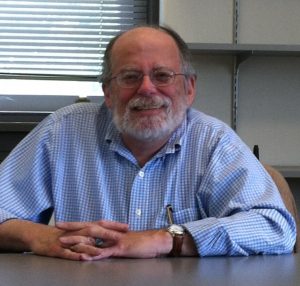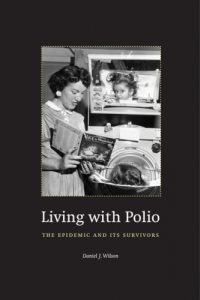 Post-Polio Health International recently lost a valuable member of its family and dedicated advocate for polio survivors, Daniel J. Wilson. Dan joined PHI’s board in 2006 and served in various roles, most recently as Board President from November of 2020 until his death this past June. He was Professor of History Emeritus at Muhlenberg College in Allentown, Pennsylvania, where he taught from 1978 to 2018 specializing in the history of medicine and history of disability.
Post-Polio Health International recently lost a valuable member of its family and dedicated advocate for polio survivors, Daniel J. Wilson. Dan joined PHI’s board in 2006 and served in various roles, most recently as Board President from November of 2020 until his death this past June. He was Professor of History Emeritus at Muhlenberg College in Allentown, Pennsylvania, where he taught from 1978 to 2018 specializing in the history of medicine and history of disability.
Dan also served on both the board of the Lehigh Valley Center for Independent Living, including two terms as president, and on the board of the Good Shepherd Rehabilitation Hospital. He was a longtime member and newsletter editor for the Lehigh Valley Post Polio Support Group before it disbanded about ten years ago.
“He not only had an extensive list of achievements, honors and recognition for his work, but he was generous with his time and energy to benefit others,” remarks fellow board member Carol Vandenakker-Albanese, MD. “The loss of his leadership, well-informed perspective and wisdom will be greatly missed.”
Below is a sampling of Dan’s prolific work on behalf of polio survivors.
Recent Interviews
“A look into the history of mandatory vaccines.” WLS-AM 890 in Chicago.
“How Polio Research is Helping in the Hunt for a Vaccine.” Wall Street Journal podcast, The Future of Everything.
“How will COVID-19 change the future? Look to history.” Salon.
“Passion, Patience, and Perseverance: Comparing the Polio Health Crisis to the COVID-19 Pandemic.” Presented by the Doylestown Bookshop and the Doylestown Rotary (Rotary District 7430), featuring Daniel Wilson, Rotary International’s Mike McGovern and Shawn Herron.
Books Living With Polio: The Epidemic and Its Survivors. University of Chicago Press, 2007
Living With Polio: The Epidemic and Its Survivors. University of Chicago Press, 2007
Polio (Biographies of Disease), Greenwood Press, 2009.
Polio Voices: An Oral History from the American Polio Epidemics and Worldwide Eradication Efforts. Eds. Daniel J. Wilson and Julie K. Silver. Westport, CT: Praeger, 2007.
“Passing in the Shadow of FDR: Polio Survivors, Passing, and the Negotiation of Disability” in Disability and Passing: Blurring the Lines of Identity. Eds. Daniel J. Wilson and Jeffrey A. Brune. Temple University Press, 2013.
Articles
“Comparing the Polio and Coronavirus Epidemics.” Post-Polio Health, Vol 36, No 2 (Spring 2020).
“Psychological Trauma and Its Treatment in the Polio Epidemics.” Bulletin of the History of Medicine, 82 (2008), 848-877.
“Braces, Wheelchairs, and Iron Lungs: The Paralyzed Body and the Machinery of Rehabilitation in the Polio Epidemics.” The Journal of Medical Humanities, 26 (Fall 2005), 173-190.
"A Crippling Fear: Experiencing Polio in the Era of FDR." Bulletin of the History of Medicine, 72 (Fall 1998), pp. 464-495.
"Covenants of Work and Grace: Themes of Recovery and Redemption in Polio Narratives." Literature and Medicine, 13 (1994), pp. 22-41.
“Basil O'Connor, the National Foundation for Infantile Paralysis and the Reorganization of Polio Research in the United States, 1935-41.” Journal of the History of Medicine and Allied Sciences. 2015 Jul;70(3):394-424.
Remembering an Olympic Champion
With the 2020 Tokyo Summer Games in full swing, it's worth looking back at a polio survivor who went on to Olympic glory. Wilma Rudolph was born in 1940 in Clarksville, Tennessee, the 20th of 22 children. She contracted polio at the age of five and wore a brace on her left leg until the age of twelve. Years of rehabilitation allowed her to start playing sports in 8th grade, taking up basketball and then track. By the time she was 16, she had qualified for the 1956 games held in Melbourne, Australia, where she won bronze in the 4x100m relay. But it was the 1960 Summer Games in Rome where she shone, winning gold in the 100m, 200m, and 4x100m relay and earning her the moniker of “the fastest women on earth.” You can read more about Rudolph here.
From the National Rehabilitation Information Center
RERC TechSAge Seeks Older Adults with Mobility Challenges for Online, Seated Tai Chi Class
The NIDILRR-funded Rehabilitation Engineering Research Center on Technologies to Support Aging-in-Place for People with Long-Term Disabilities (TechSAge RERC II) seeks participants for a clinical trial for Tele Tai Chi (PDF), an 8-week virtual seated Tai Chi program for older adults with long-term mobility disabilities. The program consists of two online classes per week on Zoom, questionnaires, and an interview. Participants must be between the ages of 60-80, have mobility challenges for at least 10 years, and have access to a computer or tablet with a webcam and internet access. Participants will be compensated $60 for their time. For more information, contact Elena Remillard, study coordinator, at elena.remillard@design.gatech.edu.
ADA.gov Invites Feedback on New Website
ADA.gov, maintained by the Department of Justice Civil Rights Division, has invited visitors to explore and provide feedback on an in-progress version of an improved website, with the goal of making the site more user friendly. The beta site currently includes an introduction to the ADA and an article on service animals, and will add a topic article on parking soon. Visitors are invited to provide feedback on the site's design and usability through a brief form.
The ADA and Caregivers: Frequently Asked Questions
The NIDILRR-funded ADA Network Knowledge Translation Center published a new factsheet, The ADA and Caregivers: Frequently Asked Questions. The factsheet covers frequently asked questions on the relevance of the Americans with Disabilities Act (ADA) to caregivers and people with disabilities who require their assistance and support. It also discusses if businesses are required under the ADA to provide a caregiver or personal assistant to people with disabilities, if caregivers are guaranteed a seat next to the person they are assisting at a ticketed event, and more. This factsheet is also available in Spanish.
National Council on Disability Calls for Better Accessibility at Health Care Facilities
The National Council on Disability wants the U.S. Department of Justice and the Department of Health and Human Services to issue new regulations outlining exact parameters for what constitutes accessible medical and diagnostic equipment. The recommendations from the National Council on Disability, which is charged with advising the president and Congress on disability issues, were issued in a 75-page report outlining the barriers still present as people with disabilities seek health care.
Here are some of the reports key findings:
NCD’s report provides the following key findings:
- More than 20 million people over the age of 18 years have a disability that limits their functional mobility and creates a barrier to accessing standard Medical Diagnostic Equipment (MDE);
- People with disabilities reported their healthcare professionals often created ad hoc “accommodations” due to inaccessible MDE that included skipping parts of the examination during which the barrier was encountered or even refusing to treat the patient due to facility’s inaccessibility;
- Medical staff are unfamiliar with the proper use of accessible MDE even when it is available;
- The U.S. Department of Justice’s Disability Rights Section (DOJ) and the U.S. Department of Health and Human Services’ Office for Civil Rights (OCR) have mechanisms to allow people with disabilities to file administrative complaints against health care providers due to inaccessible MDE, but this has not resulted in widespread change to increase the availability of accessible MDE in health care facilities.
Articles of Interest
The Echo of Polio Could Affect Hundreds of Thousands of Americans (AARP Bulletin) – A quick overview on the late effects of polio featuring PHI board member Dr. Marny Eulberg.
Polio: When vaccines and re-emergence were just as daunting (Associated Press) – AP writer Dan Sewell looks at some of the comparisons between the polio and covid epidemics.
Vaccine History Repeats Itself — Sometimes (NPR) – A look back at vaccination campaigns for various epidemics in our recent history, this article includes some wonderful photographs.
Poliovirus almost killed them and they will stop at nothing to be protected from Covid-19 (Stuff) – New Zealand polio survivors speak on the importance of vaccination.
Success of polio vaccine rollout shows we learn nothing from history (Chicago Tribune) – What can we learn from the polio epidemics of last century?
Then and now: The difference between the polio and COVID-19 vaccine eras (Times Union) – A look back at the polio vaccine rollout in upstate New York.
The arrival of the first polio vaccine in St. Louis in 1955 was greeted with relief (St. Louis Post-Dispatch) – A look at the polio vaccine rollout in St. Louis.
Leave a Legacy
Below are a few suggested donation types that can be given now during your lifetime or set up as a planned donation to Post-Polio Health International.
1. Donations of Cash: This the simplest and easiest way for you to make a donation. You may receive a charitable tax deduction on your tax return.
2. Donations of Stocks and Bonds: A donation of appreciated stocks and bonds. You could avoid capital gains taxes that would otherwise be due if you sold them directly. Contact us to facilitate.
3. Donations from Retirement Accounts: If you have Traditional or Roth IRAs and are age 70 ½ or older, you may make a qualified charitable distribution directly from these IRAs without incurring any adverse federal income tax consequences. The distribution counts toward any Required Minimum Distribution (RMD), but is not included in calculating the individual taxpayer’s limitation on charitable deductions in the year the donation is made.
4. Donations of Insurance Policies: This donation can be made outright for cash value, or by naming Post-Polio International as beneficiary.
Talk to your financial advisor or attorney about these and other ways to create a meaningful way to help Post-Polio International continue to fulfill its mission.
